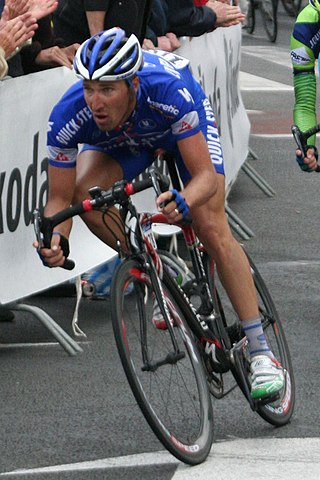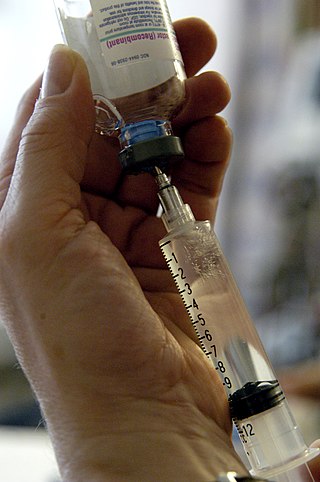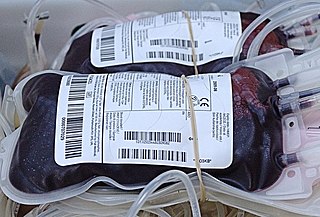Related Research Articles

Hypoxia is a condition in which the body or a region of the body is deprived of adequate oxygen supply at the tissue level. Hypoxia may be classified as either generalized, affecting the whole body, or local, affecting a region of the body. Although hypoxia is often a pathological condition, variations in arterial oxygen concentrations can be part of the normal physiology, for example, during strenuous physical exercise.

Veins are blood vessels in the circulatory system of humans and most other animals that carry blood toward the heart. Most veins carry deoxygenated blood from the tissues back to the heart; exceptions are those of the pulmonary and fetal circulations which carry oxygenated blood to the heart. In the systemic circulation arteries carry oxygenated blood away from the heart, and veins return deoxygenated blood to the heart, in the deep veins.

In cardiac physiology, cardiac output (CO), also known as heart output and often denoted by the symbols , , or , is the volumetric flow rate of the heart's pumping output: that is, the volume of blood being pumped by a single ventricle of the heart, per unit time. Cardiac output (CO) is the product of the heart rate (HR), i.e. the number of heartbeats per minute (bpm), and the stroke volume (SV), which is the volume of blood pumped from the left ventricle per beat; thus giving the formula:

Cyanosis is the change of body tissue color to a bluish-purple hue as a result of having decreased amounts of oxygen bound to the hemoglobin in the red blood cells of the capillary bed. Body tissues that show cyanosis are usually in locations where the skin is thinner, including the mucous membranes, lips, nail beds, and ear lobes. Some medications containing amiodarone or silver, Mongolian spots, large birth marks, and the consumption of food products with blue or purple dyes can also result in the bluish skin tissue discoloration and may be mistaken for cyanosis.

Exercise physiology is the physiology of physical exercise. It is one of the allied health professions, and involves the study of the acute responses and chronic adaptations to exercise. Exercise physiologists are the highest qualified exercise professionals and utilise education, lifestyle intervention and specific forms of exercise to rehabilitate and manage acute and chronic injuries and conditions.

An air embolism, also known as a gas embolism, is a blood vessel blockage caused by one or more bubbles of air or other gas in the circulatory system. Air can be introduced into the circulation during surgical procedures, lung over-expansion injury, decompression, and a few other causes. In flora, air embolisms may also occur in the xylem of vascular plants, especially when suffering from water stress.

Venous blood is deoxygenated blood which travels from the peripheral blood vessels, through the venous system into the right atrium of the heart. Deoxygenated blood is then pumped by the right ventricle to the lungs via the pulmonary artery which is divided in two branches, left and right to the left and right lungs respectively. Blood is oxygenated in the lungs and returns to the left atrium through the pulmonary veins.
Vascular resistance is the resistance that must be overcome to push blood through the circulatory system and create blood flow. The resistance offered by the systemic circulation is known as the systemic vascular resistance (SVR) or may sometimes be called by the older term total peripheral resistance (TPR), while the resistance offered by the pulmonary circulation is known as the pulmonary vascular resistance (PVR). Systemic vascular resistance is used in calculations of blood pressure, blood flow, and cardiac function. Vasoconstriction increases SVR, whereas vasodilation decreases SVR.
VO2 max (also maximal oxygen consumption, maximal oxygen uptake or maximal aerobic capacity) is the maximum rate of oxygen consumption attainable during physical exertion. The name is derived from three abbreviations: "V̇" for volume (the dot appears over the V to indicate "per unit of time"), "O2" for oxygen, and "max" for maximum. A similar measure is VO2 peak (peak oxygen consumption), which is the measurable value from a session of physical exercise, be it incremental or otherwise. It could match or underestimate the actual VO2 max. Confusion between the values in older and popular fitness literature is common. The capacity of the lung to exchange oxygen and carbon dioxide is constrained by the rate of blood oxygen transport to active tissue.
The Fick principle states that blood flow to an organ can be calculated using a marker substance if the following information is known:

Hypoxemia is an abnormally low level of oxygen in the blood. More specifically, it is oxygen deficiency in arterial blood. Hypoxemia has many causes, and often causes hypoxia as the blood is not supplying enough oxygen to the tissues of the body.
Lactate inflection point (LIP) is the exercise intensity at which the blood concentration of lactate and/or lactic acid begins to increase rapidly. It is often expressed as 85% of maximum heart rate or 75% of maximum oxygen intake. When exercising at or below the lactate threshold, any lactate produced by the muscles is removed by the body without it building up.
A cardiac shunt is a pattern of blood flow in the heart that deviates from the normal circuit of the circulatory system. It may be described as right-left, left-right or bidirectional, or as systemic-to-pulmonary or pulmonary-to-systemic. The direction may be controlled by left and/or right heart pressure, a biological or artificial heart valve or both. The presence of a shunt may also affect left and/or right heart pressure either beneficially or detrimentally.
A pulmonary shunt is the passage of deoxygenated blood from the right side of the heart to the left without participation in gas exchange in the pulmonary capillaries. It is a pathological condition that results when the alveoli of parts of the lungs are perfused with blood as normal, but ventilation fails to supply the perfused region. In other words, the ventilation/perfusion ratio of those areas is zero.
The Shunt equation quantifies the extent to which venous blood bypasses oxygenation in the capillaries of the lung. “Shunt” and “dead space“ are terms used to describe conditions where either blood flow or ventilation do not interact with each other in the lung, as they should for efficient gas exchange to take place. These terms can also be used to describe areas or effects where blood flow and ventilation are not properly matched, though both may be present to varying degrees. Some references refer to “shunt-effect” or “dead space-effect” to designate the ventilation/perfusion mismatch states that are less extreme than absolute shunt or dead space.
Cardiovascular drift is the phenomenon where some cardiovascular responses begin a time-dependent change, or "drift", after around 5–10 minutes of exercise in a warm or neutral environment 32 °C (90 °F)+ without an increase in workload. It is characterized by decreases in mean arterial pressure and stroke volume and a parallel increase in heart rate. It has been shown that a reduction in stroke volume due to dehydration is almost always due to the increase in internal temperature. It is influenced by many factors, most notably the ambient temperature, internal temperature, hydration and the amount of muscle tissue activated during exercise. To promote cooling, blood flow to the skin is increased, resulting in a shift in fluids from blood plasma to the skin tissue. This results in a decrease in pulmonary arterial pressure and reduced stroke volume in the heart. To maintain cardiac output at reduced pressure, the heart rate must be increased.

Arterial blood is the oxygenated blood in the circulatory system found in the pulmonary vein, the left chambers of the heart, and in the arteries. It is bright red in color, while venous blood is dark red in color. It is the contralateral term to venous blood.
Cardiovascular fitness refers a health-related component of physical fitness that is brought about by sustained physical activity. A person's ability to deliver oxygen to the working muscles is affected by many physiological parameters, including heart rate, stroke volume, cardiac output, and maximal oxygen consumption.
Hypoventilation training is a physical training method in which periods of exercise with reduced breathing frequency are interspersed with periods with normal breathing. The hypoventilation technique consists of short breath holdings and can be performed in different types of exercise: running, cycling, swimming, rowing, skating, etc.
The physiology of marathons is typically associated with high demands on a marathon runner's cardiovascular system and their locomotor system. The marathon was conceived centuries ago and as of recent has been gaining popularity among many populations around the world. The 42.195 km distance is a physical challenge that entails distinct features of an individual's energy metabolism. Marathon runners finish at different times because of individual physiological characteristics.
References
- 1 2 3 Malpeli, Physical Education, Chapter 4: Acute Responses to Exercise, p. 106.
- 1 2 Robertson, Claudia S.; et al. (February 1989). "Cerebral arteriovenous oxygen difference as an estimate of cerebral blood flow in comatose patients". Journal of Neurosurgery . American Association of Neurosurgeons. 70 (2): 222–230. doi:10.3171/jns.1989.70.2.0222. PMID 2913221.
- 1 2 De Cort, S. C; et al. (September 1991). "Cardiac output, oxygen consumption and arteriovenous oxygen difference following a sudden rise in exercise level in humans". The Journal of Physiology . 441: 501–512. doi:10.1113/jphysiol.1991.sp018764. PMC 1180211 . PMID 1816384.
- ↑ Malpeli, Physical Education, Chapter 11: Chronic Training Adaptations, p. 304.
- 1 2 Malpeli, Physical Education, Chapter 11: Chronic Training Adaptations, p. 307.
- 1 2 Detry, Jean-Marie R.; et al. (1971). "Increased Arteriovenous Oxygen Difference After Physical Training in Coronary Heart Disease". Circulation . American Heart Association. 44 (1): 109–118. doi: 10.1161/01.cir.44.1.109 . PMID 5561413.